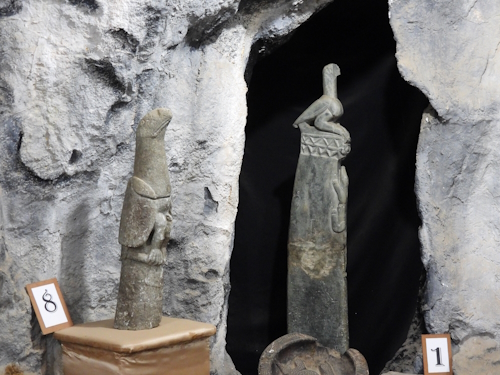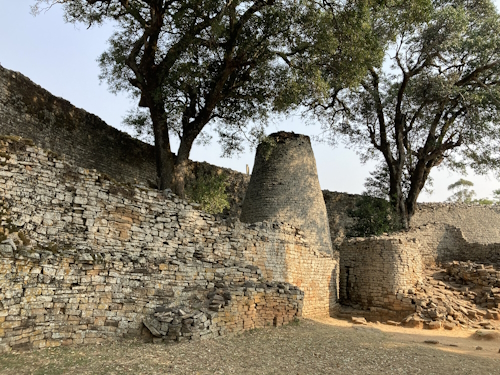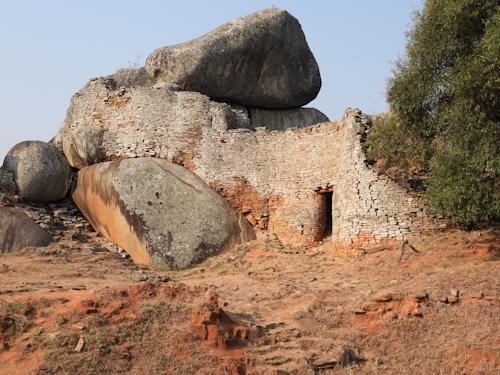Blog WHS Visits
WHS #848: Great Zimbabwe
Whatever the circumstances in Zimbabwe are, Great Zimbabwe National Monument is the country's main cultural attraction. The site saw 120,000 visitors in 1996, then the number dropped to 15,000 in 2008 and then it went back up again to 78,000 in 2018. I visited on a Saturday and encountered mostly Zimbabwean day trippers and even a busload of school children. The site is so big though that I mostly found myself wandering around the ruins alone. The refreshment area at the center was closed and a small troop of monkeys had taken over the picnic benches, probably wondering why no food-spilling people stopped there anymore.
I started my visit at the museum, having learned from Khami Ruins that although it may not look much, there still may be something worthwhile in it. This is true here: in the first room, explanation panels highlight the chronological development of the Zimbabwe tradition, their architecture and religion. The second room, at the back, houses 7 of the 8 original Zimbabwe Birds - divine soapstone sculptures that were found within the ruins and stood on top of monoliths. They are magnificent. The bird figures were cut off their pedestals and looted by various late 19th century ‘hunters’ and moved to museums in Germany and South Africa. I am happy that they have been brought back and are on display at the site museum.
To the right of the museum lies the Great Enclosure. It is accessed via a long walkway. This concentric structure with its high walls looks like a gigantic Crusader castle. It lies in a pretty setting with palm trees that are also high. The dry stone walls look neat, and I especially loved the rounded edges. You can enter via a few narrow gates, which give you access to the inner circle walls. Eventually, you’ll end up at the core area, where the conical tower stands out. The enclosure also holds standing stones, both on the ground and at the top of the walls, which may have held bird figurines.
The other main component of the Great Zimbabwe National Monument, the Hill Ruins, lies on the other side of the complex. Overall I walked 4km during my visit to the site, and there is little shade so bring sunscreen and water. The Hill Ruins are .. on a hill. I walked up via the Ancient Path – this is the steepest way but does give you excellent views of both the Hill Ruins and the Great Enclosure in the valley. The steps may have been more than 500 in number (I didn’t count), as the trail is 350m long. At the top, the path is narrowly wedged in between natural rocks. This surely was a well-defended structure as it held the residence of the chiefs. The Hill Ruins are much smaller in size than the Great Enclosure, and more use of natural elements has been made.
Just as at the Great Enclosure, there is a small covered area in the center that holds the remains of a hut. Via steps, you can climb almost all the way to the top of the Hill ruins. This may have been an area for ceremonial use, as it looks too small to live in. As at Khami, there are no information panels on site so you find yourself often guessing what you're looking at. Great Zimbabwe is the much better-studied site of the two, so there is info available online and in books. I made my way down taking the Modern Path. This slowly goes down around the outer edges of the Hill Ruins.
It is clear that the site is in dire need of money, but all the important things are kept up well. The ruins are in good condition and the site is kept clean. There is no real trail to follow but I liked the exploring – I did not hire a guide as I did not want to tag along someone for 2 hours. There are no toilets on site and no guardians except for at the entrance. They don’t have a WH plaque or obvious displays of the logo either, I think they’re bigger than that. Instead, a board at the entrance states proudly: “Proclaimed National Monument: 1937. Gave its name to the country: 1980. Enlisted a World Heritage Site: 1986”.
Els - 3 September 2023


